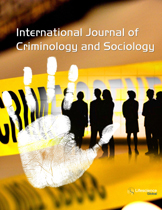ijcs
Abstract : Sex Trafficking: Examining Links to Prostitution and the Routine Activity Theory
|
|
Abstract: Sex trafficking is often a concern in international communities. However, sex trafficking victims do not always cross international boarders; these victims can be trafficked within their own countries. The purpose of the study is to examine the perceptions of law enforcement agents experienced in investigations of prostitution and sex trafficking incidents. Qualitative data were collected by interviewing law enforcement agents along the east coast region of the United States. An analysis of the interview data uncovered a series of themes which include desire for money, drug activity, lack of awareness, and varying tolerance levels. The research results were applied to the framework of routine activity theory (Cohen &Felson, 1979). It was found that the three elements (motivated offenders, suitable targets, and absence of a capable guardian) of the theory were well applied to describe sex trafficking activity. Important future research implications as well as policy implications were discussed. Keywords: Sex trafficking, prostitution, routine activities theory, law enforcement.Download Full Article |
Abstract : Judicial Perceptions of Media Portrayals of Offenders with High Functioning Autistic Spectrum Disorders
|
|
Abstract: In recent years, sensational media reporting focusing on crimes committed by those diagnosed with or thought to have High Functioning Autistic Spectrum Disorders (hfASDs) has caused societal speculation that there is a link between the disorder and violent criminality. No research exists on how and if the judiciary understands and is affected by this coverage. Therefore this study aims to examine how judges perceive and are influenced by media attention surrounding hfASDs and criminality. Semi-structured interviews were conducted with 21 California Superior Court Judges, including questions on media portrayal. Judges perceived general media portrayals of hfASDs in both positive and negative ways. However, almost all judges who had experienced media coverage surrounding hfASDs and criminality identified it as misleading and harmful to public perceptions of the disorder. These findings suggest judges are not exempt from media attention surrounding violence and hfASDs, and they recognize the potential adverse effects of this negative coverage. Although judges’ report their opinions are not affected, the results demonstrate that judges are worried that the public and potentially other criminal justice actors are adversely affected and will continue to be moving forward. Keywords: Criminal Offenders, High Functioning Autistic Spectrum Disorders, Media Portrayal, Asperger’s Syndrome, Judges, Sandy Hook.Download Full Article |
Editor’s Choice : Aging Prisoners: A Brief Report of Key Legal and Policy Dilemmas
|
|
Abstract: Background: The social phenomenon of the aging of the prison population has raised various legal and policy challenges. Objective: The goal of this brief report is to describe the current key legal-policy dilemmas in this field. Methods: A computerized search for legal documents, articles and studies using relevant key words was conducted in computerized databases. Results: Five key dilemmas were found: (1) Early and compassionate release of older prisoners; (2) Segregation or integration of older prisoners; (3) Heaven or hell? The meaning of imprisonment in old age; (4) Fixed v. tailored sentences to older offenders; and (5) Is prison the right place to send older offenders? Conclusion: Evidence regarding the unique socio-medical needs of older prisoners does not provide easy or simple answers to the legal-policy dilemmas in this field. Hence, as of today, the scholarly discussions in this field seem to be more normative (what "should" be the solution) rather than empirical (what "is" the evidence-based solution). Therefore, more empirical evidence is needed in order to design old-age based legal-policies towards older prisoners. Keywords: Older prisoners, elderly prisoners, elder law, geriatric jurisprudence, jurisprudential gerontology.Download Full Article |
Editor’s Choice : Aging Prisoners: A Brief Report of Key Legal and Policy Dilemmas (2)
|
|
Abstract: Background: The social phenomenon of the aging of the prison population has raised various legal and policy challenges. Objective: The goal of this brief report is to describe the current key legal-policy dilemmas in this field. Methods: A computerized search for legal documents, articles and studies using relevant key words was conducted in computerized databases. Results: Five key dilemmas were found: (1) Early and compassionate release of older prisoners; (2) Segregation or integration of older prisoners; (3) Heaven or hell? The meaning of imprisonment in old age; (4) Fixed v. tailored sentences to older offenders; and (5) Is prison the right place to send older offenders? Conclusion: Evidence regarding the unique socio-medical needs of older prisoners does not provide easy or simple answers to the legal-policy dilemmas in this field. Hence, as of today, the scholarly discussions in this field seem to be more normative (what "should" be the solution) rather than empirical (what "is" the evidence-based solution). Therefore, more empirical evidence is needed in order to design old-age based legal-policies towards older prisoners. Keywords: Older prisoners, elderly prisoners, elder law, geriatric jurisprudence, jurisprudential gerontology.Download Full Article |






























